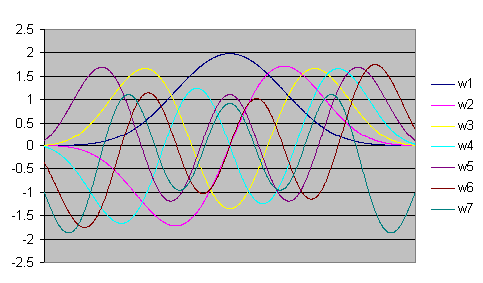Multitaper Spectral Algorithm
A multitaper spectrum is produced by averaging multiple windowed FFTs generated with a set of orthogonal data tapering windows known as discrete prolate spheroidal sequences (DPSS), Slepian functions, or eigentapers. Since each of the windows in a specific sequence is uncorrelated, an unbiased average spectrum can be produced and an F-ratio test can be used for determining the significance of any given peak in the spectrum. The seven tapers available for an nπ of 4 are graphed below. Note that only the first of the tapers has the traditional data tapering window profile.

A multitaper spectrum offers no greater frequency resolution than a single tapered spectrum. In fact, the spectral peaks resulting from the algorithm have a flat-topped envelope shape which makes the central frequency determination more difficult. What is gained is a reduced-variance spectral estimator that retains a high dynamic range and which utilizes all of the data in the record.
The Slepian data tapers are sometimes called eigentapers since they are generated using an eigenvector routine. There are two primary parameters, one that controls the frequency width of the window (Window adjustment) and the other controls the number of windows in the sequence (Number of DPSS windows). There are limits to the number of windows that can be used as spectral leakage increases as the sequence progresses. For a width of 2, up to 3 sequences are permitted. For a width of 3, up to 5 sequences are allowed, and for a width of 4, up to 7 sequences.
The first window in the Slepian sequence is included in the data taper list as Slepian (DPSS) window. It is an excellent data tapering window. The subsequent windows in a Slepian series will emphasize the data better near the edges, but they do not offer the same spectral leakage resistance and they do not compute the true frequency. Instead, they contribute to the overall envelope of a multitaper spectral peak.
Because the peaks in an averaged spectrum have this flat-top appearance, it is difficult to isolate the central peak locations from the spectrum. Instead, FlexPro uses the peaks in an F-ratio computation to isolate spectral frequencies.
Multitaper Algorithm
There are two principal DPSS multitaper algorithm variants, and their distinction is how the individual spectra are averaged. One weights by eigenvalue. The other is an adaptive procedure that is generally a better choice since it is less adversely influenced by the higher sequence spectra which evidence more spectral leakage. FlexPro implements the adaptive algorithm.
